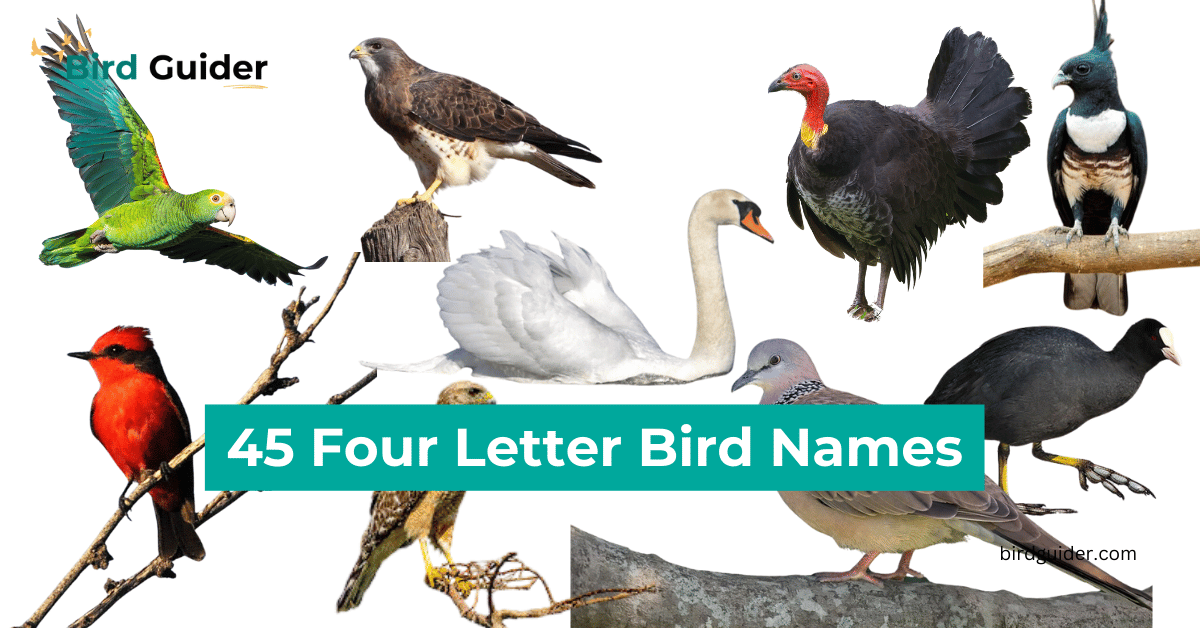Birdwatching is a popular hobby that lets people enjoy the excitement of seeing colorful birds and hearing their beautiful songs. Besides the amazing sights and sounds, there’s an interesting fact about bird names, some of them have three letters names, many of them have four letters. These short names are fun to talk about and help us learn more about the different types of birds around us.
What we have in our four letter bird names?
In this article, we explore 45 interesting four letter bird names from around the world. Some common birds like hawk, dove, duck, guan, sawn and wern may you know, but the list is long. Each name offers a glimpse into different ecosystems and unique traits.
Baza Bird

The baza bird captivates birdwatchers with its bright colors and quick hunting skills. It is 40 to 50 cm long and has chestnut or brown feathers with black-and-white patterns on its wings. This bird lives in Southeast Asia and Australia, nesting high in trees for safety. Bazas are known for their flying skills and mainly eat small mammals, reptiles, and insects, especially cicadas. Their sharp calls can be heard in forests during the day and breeding season.
Chat Bird
Chat birds are known for their bright colors, including yellows, blues, and browns. They are medium-sized with strong beaks and can live in various habitats, often nesting in low shrubs for protection. They eat insects, seeds, and berries, which they find on the ground or in low plants. Each species has its own unique calls. As migratory birds, they travel long distances and change their routes based on the environment.
Coly Bird
The Coly bird is known for its bright feathers and is 12 to 14 inches long. It lives in tropical forests and has strong beaks for eating seeds and fruits. Colies build intricate nests in tree canopies and show complex social behaviors, like playful courtship and singing. They migrate long distances to find food and nesting sites, helping to spread seeds and regenerate forests. The Coly also has cultural importance in many indigenous myths.
Coot Bird
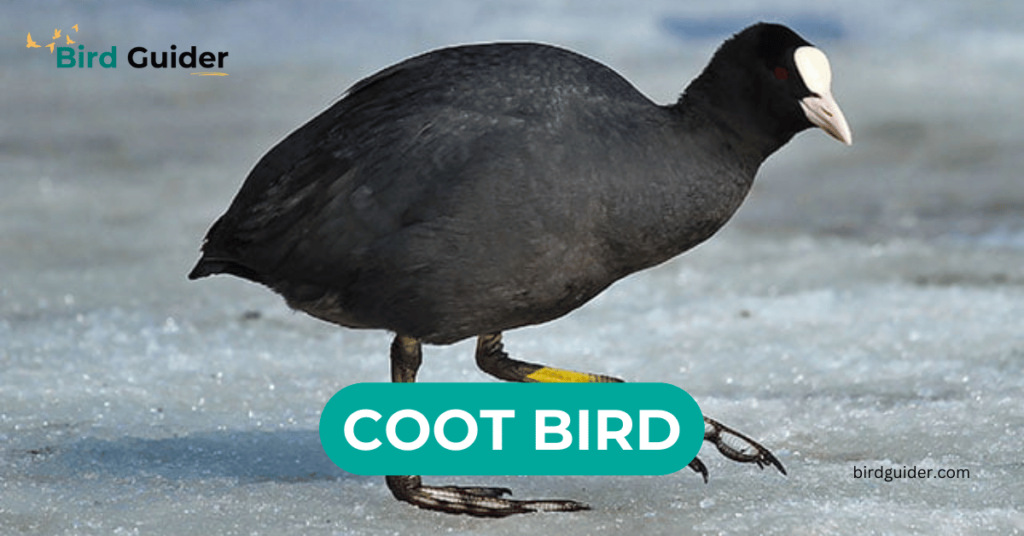
The Coot bird is 12-16 inches long and has black feathers and a white bill. Its feather patterns help attract mates, and its red eyes make it look charming. Coots like freshwater habitats and build floating nests in thick plants to stay safe from predators. They search for food by diving for water plants and small animals. Although they fly awkwardly but they are quick when scared. Some Coot populations migrate short distances outside of breeding season.
Coua Bird
The Coua bird lives in Madagascar and has bright blue and green feathers with unique patterns. These medium-sized birds have strong beaks for eating fruit and like to nest in thick plants. They mostly stay on the ground and prefer walking to flying, but they can move quickly when needed. Their diet includes fruits, insects, small reptiles, and seeds. Couas are known for their calls and perform complex mating displays.
Crow Bird
Crows are medium to large birds with shiny black feathers and strong beaks. They build nests in many places, like forests and cities, often high up. Crows are adaptable and show complex behaviors such as using tools and solving problems. They eat a variety of foods, including insects, small animals, fruits, and dead animals. They usually breed from spring to early summer, laying 3-7 eggs in hidden nests. They typically live 7-10 years in the wild but can live over 20 years in captivity.
Dodo Bird
The Dodo bird was a flightless bird from Mauritius. It was about 1 meter tall and weighed between 10 and 18 kg. The Dodo had grayish-brown feathers, lighter underparts, and curly tail feathers. Its strong, hooked beak helped it find fruits and seeds in dense coastal forests, where it nested on the ground. Dodos were active during the day and had unique feeding habits. They used their beaks to crack open hard fruits. They were territorial and lived without predators until humans arrived. Hunting and introduced species caused their extinction in the late 17th century.
Dove Bird

Dove birds include over 300 species which are from the small Inca Dove to the large Nicobar Pigeon. They usually have soft colors like grey, brown, and white and often with light patterns. Their strong beaks help them eat seeds. Doves live in many places, such as city gardens, forests, and grasslands, looking for food and shelter.
Duck Bird
Ducks come in many species, like colorful Mandarins and common Mallards. They are usually medium-sized and have bright or dull feathers for hiding. Ducks live in wetlands and build nests in reeds or grasses. They can easily switch between resting and feeding. During migration, many species show interesting flight patterns. Ducks eat aquatic plants, insects, crustaceans, and small fish.
Eyas Bird
Eyas birds are young hawks or falcons. They have bright feathers and strong features. Their brown and white feathers look different from adult birds. They have strong beaks for catching prey. Eyas birds live in grasslands and forests and like to nest high up. They are curious and active, exploring their surroundings to learn how to survive. Eyas eat small rodents and insects and use various hunting methods.
Erne Bird
The Erne is a large bird with a wingspan of 1.5 to 2 meters. It has dark grey feathers with white and black spots. Its hooked beak helps it catch fish, its main food. Ernes live in coastal areas and large waterways, nesting on high cliffs or tall trees for a good view. They are skilled flyers, soaring while searching for food and diving quickly to catch it. Their deep calls help them communicate and mark their territory during breeding season in late spring and early summer.
Fowl bird

Fowl birds, like chickens and ducks, come in different shapes and sizes. These birds usually live in farms and wetlands and like to nest in safe, hidden spots. Chickens look for food on the ground, while ducks search for food by dabbling or diving. They are most active at dawn and dusk and often make social calls during these times. Some fowl migrate long distances, while others stay in one place all year.
Guan Bird
The guan bird is part of the Cracidae family and can grow up to 90 cm long. It has a strong body with bright green and brown feathers that shine in the light. Guan birds live mainly in the tropical rainforests of Central and South America. They build nests in tall trees that look like platforms. They usually stay in one place but can fly short distances if they feel threatened. They make sounds like croaks and grunts to communicate.
Gull Bird
Gull birds come in different sizes which are from Bonaparte’s gull at 12 inches to the Great Black-backed gull at over 2 feet. They have white and gray feathers with black spots. Gulls have strong beaks and are opportunistic eaters, often found near coasts and cities. They build nests in grassy or rocky areas to protect their eggs from predators. Their diet includes fish, crustaceans, and human food, showing they can adapt well.
Hawk Bird
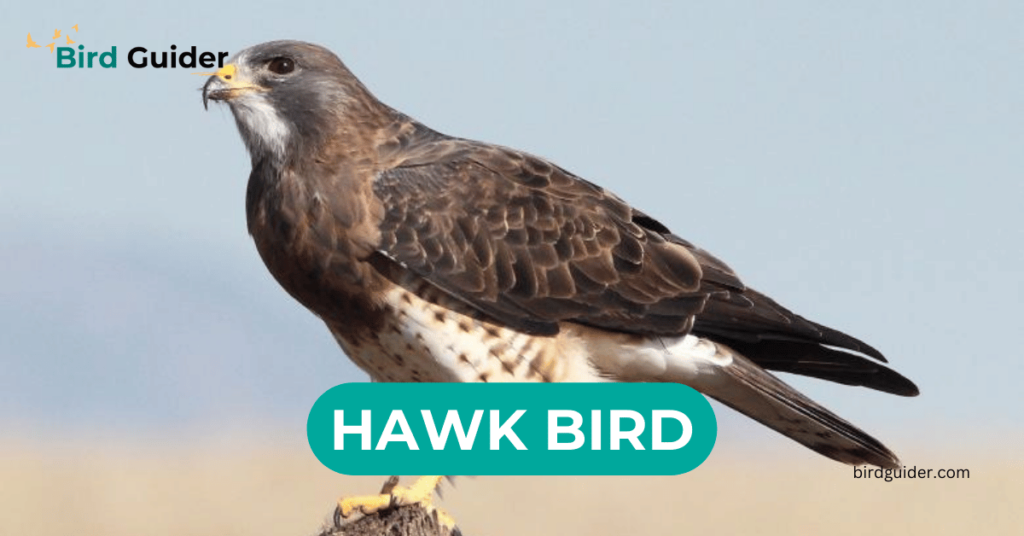
Hawks are a type of large bird of prey known for their impressive size and colorful feathers. They build nests high in trees or on ledges for safety and a good view. Their sharp eyesight and flying skills help them catch small mammals and birds. Young Red-shouldered Hawks make sounds that resemble a barking dog. Many hawks migrate each season, and females lay one to five eggs in the spring. However, hawk populations are threatened by habitat loss.
Huia Bird
The Huia bird is known for its differences between males and females. Males have shiny black feathers, while females have white-tipped tail feathers. Their long beaks help them feed in different ways: males search tree bark, and females pull grubs from wood. Huia birds lived in New Zealand’s temperate rainforests and liked to nest in mature forests. The Huia’s story shows the link between wildlife and caring for the environment.
Ibis Bird
Ibis birds come in different shapes and sizes, from the small White Ibis to the larger African Sacred Ibis. Their colors often match their homes, like the glossy ibis, which has shiny greens and purples. They have long bills to help them find food in shallow waters. Ibises like wet areas, such as marshes, and often feed in groups or migrate in V formations. They mainly eat insects, crustaceans, and small fish, along with roots and seeds.
Liwi Bird
The Iiwi bird has bright red feathers and black wings and lives in Hawaii’s mountain forests. It is about 18 centimeters long and uses its long, curved bill to drink nectar. Iiwi prefer to live at heights between 1,200 and 2,500 meters and build nests in koa trees and ohia lehuas. They are social and active birds that help pollinate flowers while making distinct calls in the forest.
Lora Bird
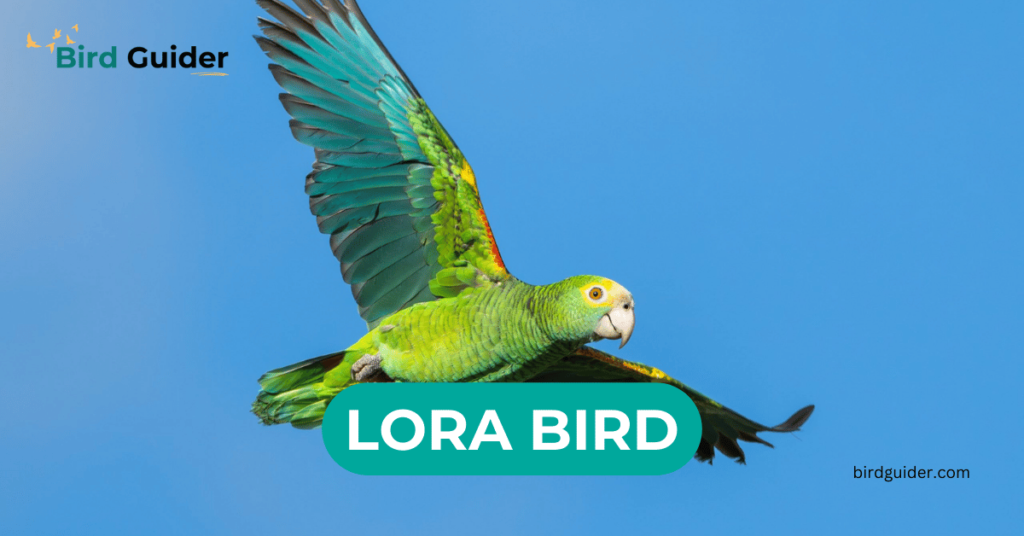
The Iora bird is a colorful 15 cm member of the Aegithinidae family. Males are bright yellow with greenish backs and black wing tips, while females are olive-green. Their slim beaks help them catch insects, which is their main food. Ioras live in dense forests and scattered woodlands in Asia and often nesting near water.
Jacu Bird
The Jacu bird has dark feathers with white patterns for hiding and communication. These medium to large birds have strong bodies, wide wings, and curved beaks that help them eat. They live in tropical forests in South America and nest in thorny bushes or tree holes. Jacus mainly eat fruits, especially berries, but they also eat insects and seeds, which helps spread seeds and support biodiversity.
Kagu Bird
The Kagu bird is a special, flightless bird from New Caledonia. It has soft gray feathers and a noticeable crest. With its curved beak, the Kagu searches for insects, crustaceans, and fruits, often at night. Kagus use melodic calls to communicate and build social connections in small groups. Conservation efforts are essential to protect Kagus and keep them in New Caledonia’s ecosystems for future generations.
Kont Bird
Knot birds are beautiful shorebirds which are 7 to 10 inches long, that change color with the seasons. Their beaks help them find small crustaceans and mollusks along the coast. They like to nest in hidden spots to stay safe from predators. They feed at low tides, communicate with soft coos, and move together in sync. These skilled migrators live in many environments and are important to ecosystems.
Kaka Bird
The Kaka is a colorful parrot from New Zealand. Males are about 48 cm long and have green feathers with orange and brown highlights. They live in mature forests and nest in tree hollows to raise their young. Kakas are good flyers and are very social, making unique calls. They move around when food is scarce and breed from September to January and lays up to four eggs.
Kiwi Bird
The Kiwi bird is a flightless bird from New Zealand that is about the size of a chicken. Kiwis are active at night and have brownish-grey feathers that help them blend in. They use their long beaks to search for insects and worms. Kiwis live in various places, making nests in burrows or thick plants, and they protect their large eggs fiercely. They mate for life and have special courtship rituals from July to January, with their unique nighttime calls loved by locals.
Kite Bird
Kite birds are quick raptors known for their sharp wings and forked tails. Their feathers come in different colors. These colors help them avoid predators and have cultural importance. Kites fly high in the sky, looking for small mammals and dead animals. They use acrobatic dives to catch their prey. They build nests in trees or on cliffs to keep their young safe.
Koel Bird
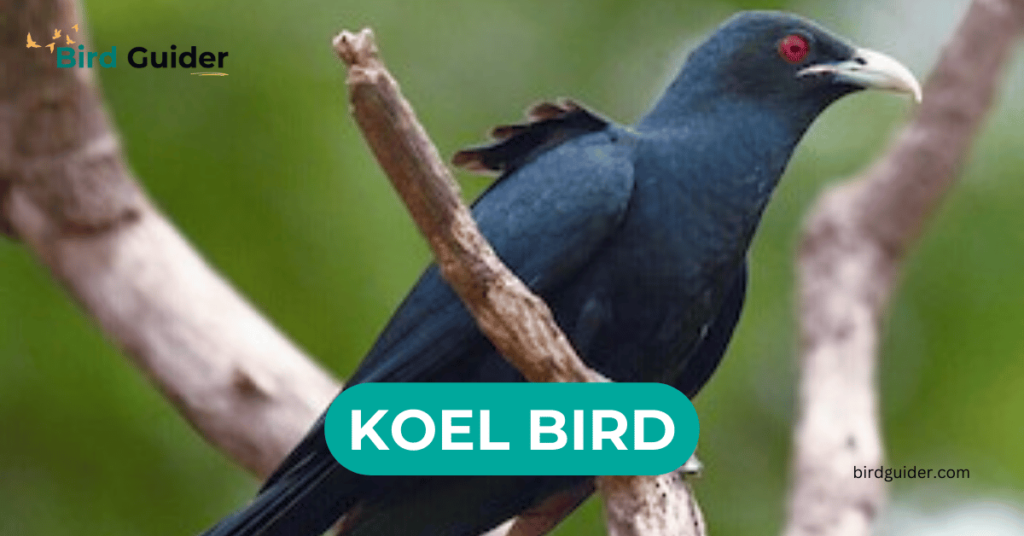
The Koel bird is part of the cuckoo family and shows differences between males and females. Males have shiny black feathers with colorful highlights, while females have brown streaked feathers for hiding. Koels live in tropical and subtropical areas of South Asia and Australia and prefers dense forests and urban gardens for nesting. They often use the nests of other birds.
Lark Bird
Lark birds are small to medium-sized with long bodies and wings. They have colorful feathers that help them blend in. Their strong beaks allow them to eat seeds and insects from the ground. Their feather patterns help them avoid predators and communicate with each other. Larks live in open areas like grasslands and build nests close to the ground. During courtship, they perform impressive aerial displays and sing complex songs that can be heard from far away.
Loon Bird
The loon bird is a striking water bird with black-and-white feathers and red eyes. It measures 2 to 3 feet long and is a skilled diver that mainly eats fish. Loons live in calm freshwater lakes in North America and northern Europe, nesting in quiet spots during breeding season. They use their eerie calls to communicate with mates and defend their territory. In winter, loons move to coastlines or larger lakes to avoid the cold. They can live over 30 years and dive up to 200 feet.
Myna Bird
The Myna bird has yellow eye patches and wing markings and measures 9 to 12 inches long. Its brown feathers contrast with white wing feathers that show up during flight. With strong beaks, mynas search for food in different places, including cities. They nest in tree holes or human-made structures, showing they can adapt well. They eat insects, fruits, and human food scraps, showing they can adjust to different environments.
Nene Bird
The Nene bird, also known as the Hawaiian Goose, stands out because of its unique look and special traits. It is 24 to 28 inches long and has brown and black colors that help it blend into Hawaii’s volcanic landscape. Its thin beak is perfect for eating local plants in grasslands and wetlands. Unlike other geese, Nene only fly short distances instead of migrating long distances. They eat grasses, fruits, and leaves, which lets them stay near their breeding areas from late October to early April.
Rook Bird
Rooks are unique birds with shiny black feathers and 16 to 18 inches long. They have long and thin bills and feathered heads, especially during breeding season. Rooks are common in open farmlands and parks in Europe and parts of Asia. They nest together in trees or man-made structures. They breed from March to June and build nests with twigs and grass, and lay 3 to 6 eggs that hatch in about two weeks.
Ruff Bird
The ruff bird is a beautiful shorebird that can grow up to 12 inches long. Males show off colorful feather ruffs during mating season. They have slim bodies, long legs, and curved beaks to search for food in the mud. Ruff birds live in shallow wetlands in Europe and Asia and do nesting in thick plants to stay safe from predators. They mainly eat insects and crustaceans, which helps them adapt.
Ruby Bird

The ruby bird is known for its bright red feathers and special survival skills. It is medium-sized and has a strong beak for drinking nectar, which has shiny red patterns that change with the light. They build nests in thick bushes or tree tops in tropical areas to hide from predators. Ruby birds have unique feeding habits, flying long distances to reach flowers that other birds can’t.
Rhea Bird
Rhea birds are flightless and look like ostriches. They stand 5.5 feet tall and weigh about 100 pounds. Their soft brown and gray feathers help them blend into grasslands. With long legs for running and flat beaks for eating, they mainly eat grasses and seeds. Rheas live in Argentina, Brazil, and Uruguay, where they nest in shallow holes lined with feathers. They are social animals that form herds for safety and use special sounds to communicate during mating.
Rail Bird
Rail birds are medium-sized but colorful birds and that why are hard to spot because of their camouflage. Their long bodies and toes help them move through marshy areas, where they mainly eat insects and plants. Rails fly short distances and have unique calls that are important for mating. Many rail species are threatened by habitat loss and climate change, but they help control insect populations and recycle nutrients.
Shag Bird
Shag birds, especially the European Shag and are beautiful with shiny black feathers and a green shine. They are 65 to 85 cm long and have long necks and pointed beaks for catching fish. They nest on steep cliffs and live in large groups with other seabirds. Their quick flying adds to the coastal scenery, but many people ignore them outside of breeding season. Shags can dive deep because they have heavy bones and webbed feet.
Skua Bird
The Skua bird is often mistaken for gulls. It is a strong scavenger that stands out due to its size and feathers. Skua species range from 20 to 26 inches long. The Great Skua has dark brown feathers, while the Pomarine Skua has shades of brown and gray. They nest in subantarctic areas, preferring rocky cliffs and tundra and where they build hidden nests. Their powerful wings allow them to migrate long distances between polar nesting sites and warmer areas.
Smew Bird
The Smew is a striking merganser with different looks for males and females. Adults are 55-65 centimeters long with long bodies and narrow heads. Their pointed beaks are perfect for catching fish. They live in northern lakes and rivers, especially in areas with plenty of aquatic life. Smews are great divers and eat small fish and crustaceans. During migration, they flap their wings quickly and glide long distances between winter and summer locations.
Sora Bird
The Sora bird is a small member of the rail family. It measures 8-10 inches and has dark brown and gray feathers with white spots, a yellow bill, and a short tail. Soras live in North America’s wetlands and nest in reed beds, where they blend in well. They search for food like seeds, insects, and crustaceans, and you can hear their sharp whistles at dusk. Breeding starts in May, and females lay 5-10 eggs in hidden nests.
Sawn Bird

Sawn bird species come in different sizes, colors, and adaptations for various habitats. They range from small pygmy sawn to large great sawn, displaying bright colors and unique patterns. Their beaks are shaped for different feeding methods, helping them reach various food sources. These birds live in wetlands, woodlands, and grasslands, often nesting in safe, hidden spots.
Teal Bird
Teal birds are loved for their bright colors and special features. They are usually small to medium-sized and have colors ranging from emerald green to bright blue and brown. Their beaks come in different shapes, either short and thick or long and thin, which helps them find food in wetlands and marshes. They have interesting feeding habits and fly smoothly to avoid danger. Teals migrate between cooler breeding areas and warmer winter spots.
Tern Bird
Tern birds have unique features like sleek bodies and long wings that help them fly quickly. They often have gray or white feathers with black caps and bright colors during mating season. Their thin beaks are perfect for diving and catching fish. Terns live in coastal areas, estuaries, and near freshwater for nesting. The Arctic Tern migrates farther than any other bird, traveling over 44,000 miles each year.
Tody Bird
The Tody bird is a small, colorful bird from the Caribbean, measuring about five inches long. Its bright green and red feathers help it blend into tropical surroundings. With strong beaks, Tody birds search for insects in moss and bark, flying with quick flutters and glides. They like humid subtropical areas and nest in tree holes and thick shrubs.
Weka Bird
The Weka is a flightless bird from New Zealand, standing 40-50 cm tall. It has brown feathers and long legs for moving through thick plants. Its curved beak, which can be up to 10 cm long, helps it dig in the soil for food. Unlike colorful birds, Wekas attract mates with soft cooing sounds. They are omnivores, eating insects, berries, and roots, mostly foraging on the ground. Wekas are curious and perform lively courtship rituals from August to December.
Wren Bird
Wrens are small birds, measuring 3 to 6 inches. They have different feather colors and slim beaks for searching for food. They live in bushes and gardens, nesting low in thick plants and showing active behavior. Wrens are famous for their cheerful songs and can eat insects, seeds, and berries when food is scarce. Wrens usually live about 4 to 5 years, but some can live longer because of their camouflage.
Conclusion
Four-letter bird names show a wide variety of bird species. Birds like Baza, Huia, Dove, and Crow have special traits that highlight nature’s creativity. These names invite us to explore and appreciate birds and their roles in the ecosystem. Learning about their habitats and behaviors can help with conservation efforts. Watching local birds lets us enjoy their diversity and the beauty of nature.
FAQ’S
What are some common four-letter bird names?
Some common four-letter bird names are dove, crow, hawk, duck, koel and sawn.
Can I use four-letter bird names for pets?
Absolutely, you can use four-letter bird names for pets! Many bird names are short and catchy, making them perfect for pet naming.
What big bird has four letters in name?
One of the most well-known big birds with a four-letter name is the emu. Native to Australia, emus are large flightless birds that can reach heights of up to six feet.

